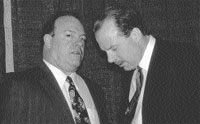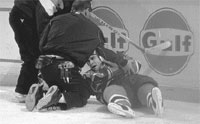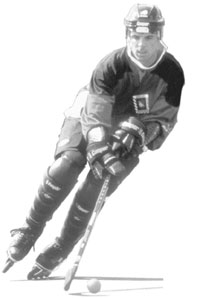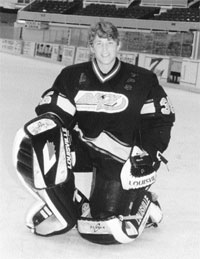Power play tactics
By Dean Chadwin
Oct 30, 2001, 11:03
 |
At the foot of the master? Keenan listens to Scotty.
©BBS |
While perusing the archives at the Hockey Hall of Fame recently, I found a tape labeled “Mike Keenan/Power Play Tactics.” This was strange. Hadn’t Keenan always emulated his idol, Scotty Bowman, and refused to even teach the power play during the regular season? What could heknow?
My curiosity got the better of me and I pulled out the cassette. It turns out Keenan does know power plays—or at least he did in 1987 when he gave a lecture at a coaching clinic in York, Ontario. What I learned from listening to that lecture can help players and coaches at any level of hockey.
Keenan opened the lecture by emphasizing the importance of power-play efficiency at playoff time. His stats showed that teams win the Cup by scoring power-play goals, and it’s a trend has been particularly evident recently. In fact, the Keenan-led 1987 Flyers—which featured Tim Kerr’s ability to create traffic, deflect the puck, and jam home rebounds—is the last team to lose the finals while scoring more power-play goals than their competition.
Over the last seven years, the Cup-winning teams scored 41 power-play goals in 37 games, while their opponents netted just 18. Sure, great teams have great players, but the skills of a Leetch, Zubov, Coffey, Lemieux, or Gretzky are even more apparent on the power play. If you want to win games or titles, you have to have an excellent power play.
Plan ahead
The first thing you need to do is make your plans at the beginning of the season by asking yourself some questions.
Are you going to use all your players on the power play, or are you going to use special units?
At the NHL level, the game requires power-play specialists. Keenan stated that the most important quality of a good power-play unit is using the best players you can find. You may not have the luxury of coaching a Chelios or a Messier, but what you want are players with certain skills. Keenan prefers players who combine some of five key attributes; one-time passers, one-time shooters (including using the backhand), the ability to read defenses, maintain puck control and work under pressure. (The latter is the one attribute Keenan believes is the most difficult to teach).
The specialists must be players who understand the proper use of space, and puckhogs who are selfish with the biscuit and can control the play. Keenan rewards hard-working, but less-talented, checking lines with power-play shifts only when he’s got a significant lead.
Are you going to practice power-play tactics extensively, or will you work instead on the particular skills involved?
Even if you don’t have talented specialists on your team, you can work to develop the important skills. Keenan’s teams work on the power-play as a whole less than 10% of their practice time during the regular season. However, they run a number of drills that are designed to improve skills that are incorporated within the power-play, such as one-time passing and shooting drills. Keenan quotes his idol Bowman, who once wrote, “Hockey is a transitional game. Grandiose, intricate plays do not work.”
In other words, according to Keenan, instead of working on plays, develop your skills.
Do you have enough resources (ice time, assistant coaches, etc.) to practice the power play?
You may have limited ice time, no assistant coaches, or perhaps no coach at all. No matter. You can still use what you have to improve. In his last year coaching in the AHL, Keenan gave the responsibility for running the power-play practice to his most experienced player, the team’s captain. While Keenan worked with most of the roster, his captain took the team’s power-play unit to the other end of the ice and ran them through a variety of passing drills. Despite the fact that a player supervised the power-play drills, this team won the AHL championship’s Calder Cup.
How can you shape your power play to fit your talent?
Don’t be afraid to move players around to take advantage of their skills. When he coached the Flyers, Keenan often moved Mark Howe up from defense to left wing during the power play to take advantage of his good hands and brilliant hockey sense. This year, the Canucks often used the speedy Pavel Bure on the point during the power-play so their other forwards could set him up to shoot one-timers while moving to the net.
Emphasize your strengths. If you have someone with a big shot at the point, run screens and create traffic in front of the net so you can take full advantage of those blasts.
Scout your opponent
Even if you’ve planned from day one, you’re still going to have to play games one at a time. If possible, before any game, you should scout your opponent, the officials, and the rink itself. Does your opponent lay back or forecheck aggressively? Who will be penalty killing? Do they stay in their box or run any special plays? For example, when Gretzky killed penalties for the Oilers, he would break for the opponent’s blueline as soon as Edmonton gained control of the puck, even if the puck was along the boards or deep in the Oilers zone. To avoid getting burned by the long break-out pass, Keenan had to make sure his players would anticipate Gretz doing this.
Know the tendencies of your referee. How much does he play to the score? Does he look for make-up calls? How much will he allow the penalty-killers to get away with? Does he favor the home team or bend over backwards to be fair?
Ask someone the dimensions of the rink. Is it small? What about the shape of the corners? How much space is there to operate behind the net? On smaller ice surfaces, your power play unit should emphasize tips and screens because you’ve got less time for clean plays.
Make your players aware of the referee’s tendencies and the nature of the playing surface and they’ll be able to adapt accordingly.
Like any other element of the game of hockey, a good power play requires hard work. Hard practice will refine the skills needed to have a high rate of efficiency. Hard work during the power play—aggressive skaters anticipating the flow of play, with their feet in constant motion—will pay off with good results. And because truly hard work is physically draining, use quick changes to keep fresh bodies on the ice.
One lesson players at any level can learn from Keenan is patience during the power play. If you enter the offensive zone with control of the puck, don’t be afraid to turn and stop. This will buy time for your fellow attackers to get into position, and will create open space in the attacking zone.
Keenan stresses using the whole two minutes. Be selfish in maintaining possession of the puck, and don’t just take your first chance to shoot. Mike notes that even the most knowledgeable hockey fans often scream for their teams to shoot far too early on the power play. Even smart fans (many of whom are also players) are used to watching their favorite players attack whenever possible during even-strength situations. What they forget is that a power play is the only time in hockey when you can truly possess the puck.
So if there’s one key lesson to be learned for every player and coach, it’s to not just fire the first open shot. Instead, use your passing skills, screens in front of the net, etc., to get great position. Make the penalty killers work. Take your time, break down the defense, and then, when you have the shot you want, take it.
I bet you’ve learned something already. So although his teams rarely practice them, Mike Keenan understands power plays. The accompanying sidebar summarizes Keenan’s 10 principles of a successful power play. Keep them in mind when working on your own, and you’ll be well on your way to a successful power play.
Mike Keenan’s 10 Power Play Commandments
#1. Always provide support.
The puck carrier should never face a pressured one-on-one situation. There should always be good passing options. Another skater should be open nearby in case the skater with the puck gets into trouble.
#2. Work the seams.
Move players and passes through the areas that divide the box. This will confuse the defense or force them to move out of position. Maybe they’ll get puck-happy and two defenders will close on the puck carrier and one pass will find an open sniper near the net.
#3. Prepare the prime scoring area.
The prime scoring area depends on your talent. If you have a Tim Kerr, you need him to get in front of the net and feed him the puck. If you have an Al MacInnis, you’ll want to screen the goalie and set up a point blast. If you’ve got a highly-mobile Zubov or Bure at the point, create an alley for them to drive to the net and receive a cross-ice pass.
#4. Switch positions.
Confuse the defense by having your players weave around the ice. This will create screens and picks and may force the defensive players to make bad decisions.
#5. Avoid long passes.
The player supporting the puck carrier should always stay close because maintaining possession is all-important, and long passes mean high risk of interception.
#6. Control the faceoff.
To maintain possession, you’ve got to get the puck first. Do whatever it takes. Make sure you always have your best players on the ice for key faceoffs.
#7. Move the puck in deep.
Unless you have Gretzky-like talent, never stop right at the blueline when you first enter the zone. Always carry the puck at least ten feet in. You might move it back out to the high point later, but you want to establish control in the attacking zone first.
#8. Create movement.
The more motion you create with the puck and your players, the more disorganized the defensive box will become. That’s the way you break open the seams and create open shots in prime scoring areas.
#9. Initiate the action.
While it’s important to be patient and not take the first open shot (unless it’s a great one), pressure should be maintained at all times. Don’t allow one-on-one duels along the boards—offer support instead.
#10. Influence the goalie.
Make the netminder move. Force him out of position. All your other efforts will be irrelevant if the goalie is ready, square and unscreened. You need to disrupt the puck-stopper by creating traffic, moving the puck behind the net or from side-to-side, and attacking this weakness.
Dean Chadwin is the author of Rocking the Pond: The First Season of the Mighty Ducks of the Anaheim.
This first appeared in the 08/1995 issue of Hockey Player Magazine®
© Copyright 1991-2001 Hockey Player® and Hockey Player Magazine®










